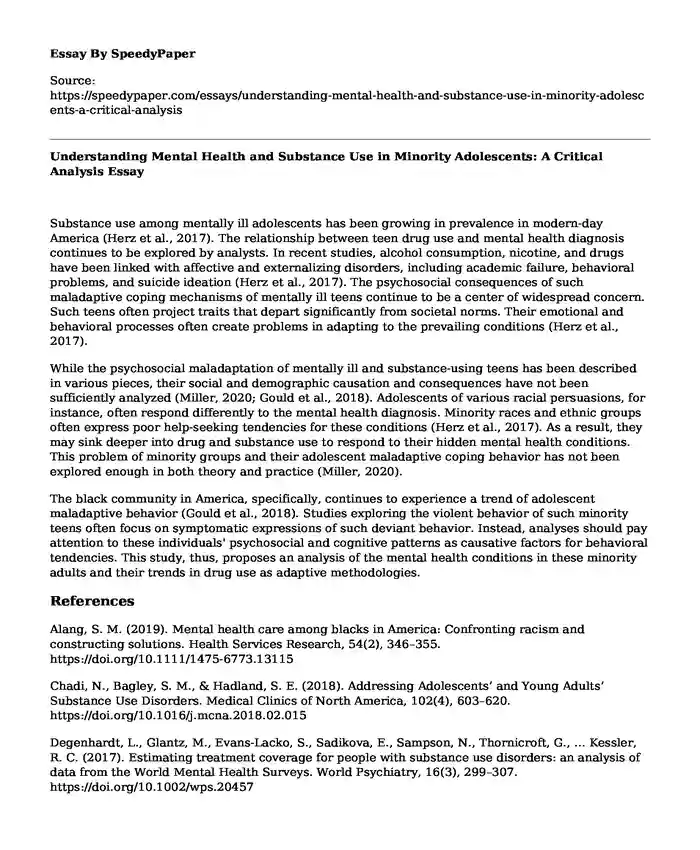
| Type of paper: | Essay |
| Categories: | Psychology Mental health |
| Pages: | 3 |
| Wordcount: | 821 words |
Substance use among mentally ill adolescents has been growing in prevalence in modern-day America (Herz et al., 2017). The relationship between teen drug use and mental health diagnosis continues to be explored by analysts. In recent studies, alcohol consumption, nicotine, and drugs have been linked with affective and externalizing disorders, including academic failure, behavioral problems, and suicide ideation (Herz et al., 2017). The psychosocial consequences of such maladaptive coping mechanisms of mentally ill teens continue to be a center of widespread concern. Such teens often project traits that depart significantly from societal norms. Their emotional and behavioral processes often create problems in adapting to the prevailing conditions (Herz et al., 2017).
While the psychosocial maladaptation of mentally ill and substance-using teens has been described in various pieces, their social and demographic causation and consequences have not been sufficiently analyzed (Miller, 2020; Gould et al., 2018). Adolescents of various racial persuasions, for instance, often respond differently to the mental health diagnosis. Minority races and ethnic groups often express poor help-seeking tendencies for these conditions (Herz et al., 2017). As a result, they may sink deeper into drug and substance use to respond to their hidden mental health conditions. This problem of minority groups and their adolescent maladaptive coping behavior has not been explored enough in both theory and practice (Miller, 2020).
The black community in America, specifically, continues to experience a trend of adolescent maladaptive behavior (Gould et al., 2018). Studies exploring the violent behavior of such minority teens often focus on symptomatic expressions of such deviant behavior. Instead, analyses should pay attention to these individuals' psychosocial and cognitive patterns as causative factors for behavioral tendencies. This study, thus, proposes an analysis of the mental health conditions in these minority adults and their trends in drug use as adaptive methodologies.
References
Alang, S. M. (2019). Mental health care among blacks in America: Confronting racism and constructing solutions. Health Services Research, 54(2), 346–355. https://doi.org/10.1111/1475-6773.13115
Chadi, N., Bagley, S. M., & Hadland, S. E. (2018). Addressing Adolescents’ and Young Adults’ Substance Use Disorders. Medical Clinics of North America, 102(4), 603–620. https://doi.org/10.1016/j.mcna.2018.02.015
Degenhardt, L., Glantz, M., Evans-Lacko, S., Sadikova, E., Sampson, N., Thornicroft, G., … Kessler, R. C. (2017). Estimating treatment coverage for people with substance use disorders: an analysis of data from the World Mental Health Surveys. World Psychiatry, 16(3), 299–307. https://doi.org/10.1002/wps.20457
Gould, M., Lake, A., Kleinman, M., Galfalvy, H., Chowdhury, S., & Madnick, A. (2018). Exposure to Suicide in High Schools: Impact on Serious Suicidal Ideation/Behavior, Depression, Maladaptive Coping Strategies, and Attitudes toward Help-Seeking. International Journal of Environmental Research and Public Health, 15(3), 455. https://doi.org/10.3390/ijerph15030455
Han, B., Compton, W. M., Blanco, C., & Colpe, L. J. (2017). Prevalence, Treatment, And Unmet Treatment Needs Of US Adults With Mental Health And Substance Use Disorders. Health Affairs, 36(10), 1739–1747. https://doi.org/10.1377/hlthaff.2017.0584
Herz, V., Franzin, N., Huemer, J., Mairhofer, D., Philipp, J., & Skala, K. (2017). Substance use and misuse among children and youth with mental illness. Neuropsychiatrie, 32(1), 18–25. https://doi.org/10.1007/s40211-017-0231-4
Li, X., Borodovsky, J. T., Kasson, E. M., Fentem, A., & Cavazos-Rehg, P. A. (2020). An analysis of within-subject and population level risk related to substance use and mental health outcomes among adolescents in the PATH study. Drug and Alcohol Dependence, 218, 108385. https://doi.org/10.1016/j.drugalcdep.2020.108385
Mcginty, E., Pescosolido, B., Kennedy-Hendricks, A., & Barry, C. L. (2018). Communication Strategies to Counter Stigma and Improve Mental Illness and Substance Use Disorder Policy. Psychiatric Services, 69(2), 136–146. https://doi.org/10.1176/appi.ps.201700076
Mckee, S. A. (2017). Concurrent substance use disorders and mental illness: Bridging the gap between research and treatment. Canadian Psychology/Psychologie Canadienne, 58(1), 50–57. https://doi.org/10.1037/cap0000093
Miller, C. (2020, January 28). Mental Health Disorders and Teen Substance Use. Child Mind Institute. https://childmind.org/article/mental-health-disorders-and-substance-use/.
Paraskevopoulou, M., Rooij, D. V., Batalla, A., Chauvin, R., Luijten, M., Schene, A. H., … Schellekens, A. F. A. (2020). Effects of substance misuse on reward-processing in patients with attention-deficit/hyperactivity disorder. Neuropsychopharmacology. https://doi.org/10.1038/s41386-020-00896-1
Penzenstadler, L., Kolly, S., Rothen, S., Khazaal, Y., & Kramer, U. (2018). Effects of substance use disorder on treatment process and outcome in a ten-session psychiatric treatment for borderline personality disorder. Substance Abuse Treatment, Prevention, and Policy, 13(1). https://doi.org/10.1186/s13011-018-0145-6
Prince, J. D., & Wald, C. (2018). Risk of criminal justice system involvement among people with co-occurring severe mental illness and substance use disorder. International Journal of Law and Psychiatry, 58, 1–8. https://doi.org/10.1016/j.ijlp.2018.02.002
Stringer, K. L., Marotta, P., Goddard-Eckrich, D., Akuffo, J., Richer, A. M., El-Bassel, N., & Gilbert, L. (2019). Mental Health Consequences of Sexual Misconduct by Law Enforcement and Criminal Justice Personnel among Black Drug-Involved Women in Community Corrections. Journal of Urban Health, 97(1), 148–157. https://doi.org/10.1007/s11524-019-00394-w
Tobin, C. S. T., Erving, C. L., Hargrove, T. W., & Satcher, L. A. (2020). Is the Black-White mental health paradox consistent across age, gender, and psychiatric disorders? Aging & Mental Health, 1–9. https://doi.org/10.1080/13607863.2020.1855627
Cite this page
Understanding Mental Health and Substance Use in Minority Adolescents: A Critical Analysis. (2024, Jan 30). Retrieved from https://speedypaper.com/essays/understanding-mental-health-and-substance-use-in-minority-adolescents-a-critical-analysis
Request Removal
If you are the original author of this essay and no longer wish to have it published on the SpeedyPaper website, please click below to request its removal:
- Free Essay: The Physique of Disney Princesses Negatively Affects Young Girls Body Images
- Paper Sample on Coaches' Perceptions of Benefits and Barriers of Trust in Football Coaching
- Risk Perception and Communication Theory - Essay Sample
- Metformin: A Popular and Effective First-Line Treatment for Type 2 Diabetes - Essay Sample
- Free Paper: The Impact of Performance Measurement on Decision-Making to Achieve the Desired Outcomes in Healthcare
- Effects of Obesity - Essay Sample
- Examining Nursing Negligence in Diabetic Patient Care: Causes, Criticisms, and Misconceptions
Popular categories




